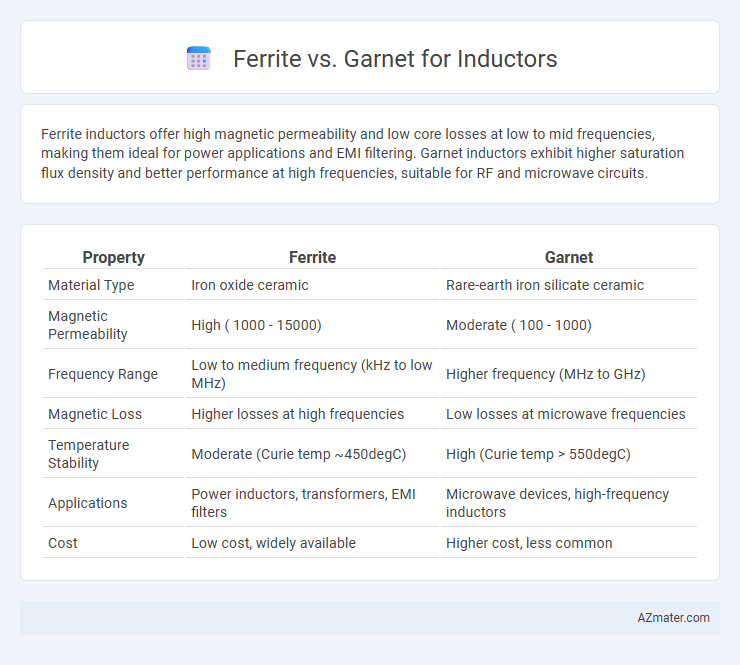Ferrite inductors offer high magnetic permeability and low core losses at low to mid frequencies, making them ideal for power applications and EMI filtering. Garnet inductors exhibit higher saturation flux density and better performance at high frequencies, suitable for RF and microwave circuits.
Table of Comparison
| Property | Ferrite | Garnet |
|---|---|---|
| Material Type | Iron oxide ceramic | Rare-earth iron silicate ceramic |
| Magnetic Permeability | High ( 1000 - 15000) | Moderate ( 100 - 1000) |
| Frequency Range | Low to medium frequency (kHz to low MHz) | Higher frequency (MHz to GHz) |
| Magnetic Loss | Higher losses at high frequencies | Low losses at microwave frequencies |
| Temperature Stability | Moderate (Curie temp ~450degC) | High (Curie temp > 550degC) |
| Applications | Power inductors, transformers, EMI filters | Microwave devices, high-frequency inductors |
| Cost | Low cost, widely available | Higher cost, less common |
Introduction to Ferrite and Garnet Materials
Ferrite materials, composed primarily of iron oxide mixed with metallic elements like nickel, zinc, or manganese, exhibit high magnetic permeability and low electrical conductivity, making them ideal for high-frequency inductor cores due to minimal eddy current losses. Garnet materials, such as yttrium iron garnet (YIG), possess a unique crystalline structure offering lower magnetic losses at microwave frequencies but generally lower permeability compared to ferrites, which limits their use to specialized RF applications. The choice between ferrite and garnet cores depends on operating frequency, magnetic properties like saturation magnetization, and core losses tailored to the inductor's intended electronic environment.
Fundamental Properties of Ferrite Inductors
Ferrite inductors offer high magnetic permeability and low core loss, making them ideal for high-frequency applications up to several MHz. They provide excellent saturation magnetization levels and stable performance across a wide temperature range, enhancing efficiency in power supply circuits. Compared to garnet, ferrite cores deliver superior inductance values and better thermal management, crucial for compact and high-performance inductor designs.
Key Characteristics of Garnet Inductors
Garnet inductors exhibit higher saturation magnetization and superior thermal stability compared to ferrite inductors, making them ideal for high-frequency and high-power applications. Their enhanced quality factor (Q) and lower core losses enable efficient signal processing and reduced energy dissipation. Garnet materials also offer increased magnetic permeability and better resistance to temperature fluctuations, ensuring consistent performance under varying operating conditions.
Magnetic Permeability Comparison: Ferrite vs Garnet
Ferrite inductors exhibit high magnetic permeability, typically ranging from 1,000 to 15,000, which allows efficient magnetic flux conduction and supports high-frequency applications. Garnet materials, with permeability values around 1,000 to 5,000, offer lower magnetic permeability but provide superior thermal stability and reduced eddy current losses. The choice between ferrite and garnet depends on the specific inductance requirements, operating frequency, and thermal considerations, making ferrite favorable for high inductance and garnet advantageous in high-power, high-temperature environments.
Frequency Response Differences
Ferrite cores excel in high-frequency applications, typically ranging from 50 kHz to several MHz, due to their low core losses and high magnetic permeability, which enables efficient energy storage and minimal heat generation. Garnet cores, on the other hand, offer superior performance at lower frequencies, generally below 100 kHz, thanks to their higher saturation magnetization and better thermal stability. The choice between ferrite and garnet for inductors hinges on the operating frequency, with ferrite preferred for switching power supplies and RF circuits while garnet suits audio and low-frequency signal processing tasks.
Core Loss Performance Analysis
Ferrite cores typically exhibit lower core losses at high frequencies due to their higher resistivity and optimized magnetic properties, making them ideal for switching power supplies and RF applications. Garnet cores, with higher saturation flux density but increased eddy current losses at elevated frequencies, are better suited for lower frequency inductors where core loss minimization is less critical. Analyzing core loss performance reveals ferrite cores outperform garnet in efficiency and thermal stability under high-frequency operation, emphasizing their preference in modern inductor design.
Temperature Stability in Ferrite and Garnet Inductors
Ferrite inductors offer superior temperature stability with a low core loss and minimal permeability variation across a wide temperature range, making them suitable for high-frequency applications. Garnet inductors, while providing high magnetic saturation and low eddy current losses, exhibit more significant permeability changes with temperature fluctuations. Temperature stability in ferrite cores ensures consistent inductance and performance in varying thermal environments, whereas garnet cores require compensation techniques to maintain operational reliability.
Application Suitability: Where Ferrite Excels
Ferrite cores excel in high-frequency applications such as switching power supplies, RF transformers, and EMI filters due to their low core losses and high permeability, enabling efficient energy transfer and reduced heat generation. Ferrite materials are preferred for applications requiring minimal magnetic saturation and stable performance under varying temperatures and frequencies. Their superior performance at frequencies above 100 kHz makes ferrite inductors ideal for compact, high-efficiency power conversion systems.
Application Suitability: Where Garnet Leads
Garnet inductors excel in high-frequency applications such as RF circuits and wireless communication systems due to their superior frequency stability and lower core losses compared to ferrite. Garnet materials provide enhanced magnetic properties that support efficient signal transmission in microwave frequencies, making them ideal for radar and satellite technologies. Their ability to maintain performance under thermal stress also positions garnet as the preferred choice for precision inductors in advanced electronics.
Choosing the Right Material: Ferrite or Garnet for Inductors
Ferrite inductors are preferred for high-frequency applications up to a few MHz due to their low core losses and high magnetic permeability, enabling efficient energy storage and reduced heat generation. Garnet inductors, with higher saturation flux density and lower coercivity, suit high-power, low-frequency scenarios where magnetic stability and reduced core losses under heavy load are critical. Selecting ferrite or garnet cores depends on operating frequency, power handling requirements, and thermal performance demands to optimize inductor efficiency and reliability.

Infographic: Ferrite vs Garnet for Inductor
 azmater.com
azmater.com